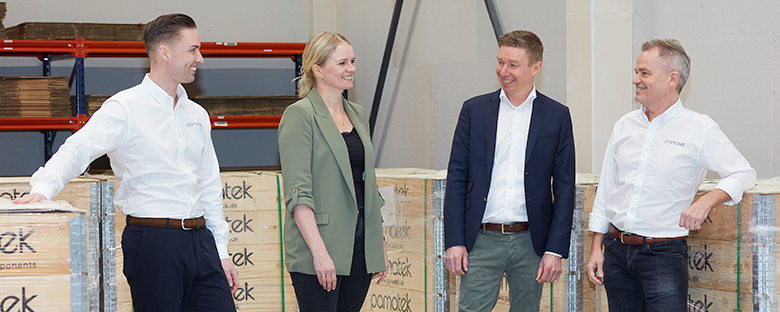Pamatek purchases ocean biofuel for all their projected needs in 2024
Pamatek purchases ocean biofuel for all their projected needs in 2024 Scan Global Logistics



Pamatek Implements Sustainable Transport to Reduce CO2 Footprint
Pamatek, a supplier of technical components and products and a subcontractor to several major lighting and interior design brands, is responding to the increasing demand from its market-leading customers to reduce its overall CO2 footprint. The company recognizes that sustainable transport is a crucial competitive parameter and has partnered with SGL to achieve this goal.
Collaboration Promotes Sustainable Solutions
Unlike many customers who opt for alternative fuels for selected freight routes, Pamatek takes a different approach by purchasing sustainable fuel for all its ocean freight from China upfront. This proactive decision demonstrates their commitment to reducing emissions and improving their positioning in the market. Any excess biofuel at the end of the year cannot be carried over to the following year’s consumption if the emissions target is not met, further emphasizing Pamatek’s dedication to sustainability.
Pamatek is also exploring opportunities in road and airfreight, considering sustainable trucking fuels for last-mile container freight and the Sea-Air combination of ocean and airfreight as alternatives to reduce CO2 emissions.
Sustainable Fuel Offers Multiple Benefits
Ocean biofuel not only benefits the environment but also helps companies achieve their reduction targets. By purchasing ocean biofuel instead of fossil fuel-powered ocean freight, Pamatek can avoid fees imposed by the EU starting from January 2024. This initiative aligns with Pamatek’s commitment to sustainable transport solutions.
How Pamatek Purchased Ocean Biofuel – Step by Step
|
The Trickle-Down Effect
Pamatek recognizes the growing trend among its customers to pressure suppliers to adopt sustainable practices. This trend was confirmed by Johnny Møller, CEO of Pamatek, who stated that sustainable transport is increasingly becoming a differentiator in the market. Pamatek uses this trend constructively by challenging and supporting its subcontractors, such as China, to adopt sustainable production methods.
SDGs, Targets, and Indicators
1. Which SDGs are addressed or connected to the issues highlighted in the article?
- SDG 7: Affordable and Clean Energy
- SDG 9: Industry, Innovation, and Infrastructure
- SDG 13: Climate Action
- SDG 17: Partnerships for the Goals
2. What specific targets under those SDGs can be identified based on the article’s content?
- SDG 7.2: Increase substantially the share of renewable energy in the global energy mix.
- SDG 9.4: Upgrade infrastructure and retrofit industries to make them sustainable, with increased resource-use efficiency and greater adoption of clean and environmentally sound technologies and industrial processes.
- SDG 13.2: Integrate climate change measures into national policies, strategies, and planning.
- SDG 17.17: Encourage and promote effective public, public-private, and civil society partnerships, building on the experience and resourcing strategies of partnerships.
3. Are there any indicators mentioned or implied in the article that can be used to measure progress towards the identified targets?
- Indicator for SDG 7.2: Share of renewable energy in the total energy consumption of the company.
- Indicator for SDG 9.4: Adoption of sustainable fuel and technologies in transportation.
- Indicator for SDG 13.2: Reduction in CO2 emissions from transportation.
- Indicator for SDG 17.17: Number of partnerships and collaborations established to promote sustainable transportation.
SDGs, Targets, and Indicators
| SDGs | Targets | Indicators |
|---|---|---|
| SDG 7: Affordable and Clean Energy | Increase substantially the share of renewable energy in the global energy mix. | Share of renewable energy in the total energy consumption of the company. |
| SDG 9: Industry, Innovation, and Infrastructure | Upgrade infrastructure and retrofit industries to make them sustainable, with increased resource-use efficiency and greater adoption of clean and environmentally sound technologies and industrial processes. | Adoption of sustainable fuel and technologies in transportation. |
| SDG 13: Climate Action | Integrate climate change measures into national policies, strategies, and planning. | Reduction in CO2 emissions from transportation. |
| SDG 17: Partnerships for the Goals | Encourage and promote effective public, public-private, and civil society partnerships, building on the experience and resourcing strategies of partnerships. | Number of partnerships and collaborations established to promote sustainable transportation. |
Behold! This splendid article springs forth from the wellspring of knowledge, shaped by a wondrous proprietary AI technology that delved into a vast ocean of data, illuminating the path towards the Sustainable Development Goals. Remember that all rights are reserved by SDG Investors LLC, empowering us to champion progress together.
Source: scangl.com

Join us, as fellow seekers of change, on a transformative journey at https://sdgtalks.ai/welcome, where you can become a member and actively contribute to shaping a brighter future.







